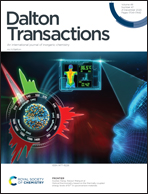Crystal structure and thermodynamic properties of dinickel diphosphate dihydrate Ni2(H2O)2[P2O7]†
Abstract
Single crystals of dinickel diphosphate dihydrate, Ni2(H2O)2[P2O7], have been synthesized by a hydrothermal method. Its structure was refined in the monoclinic P21/n space group (unit cell parameters a = 6.2517(1) Å, b = 13.7892(3) Å, c = 7.2894(2) Å, β = 94.507(2)°, V = 626.45(2) Å3, and Z = 4) based on low-temperature X-ray diffraction data until R – 0.016. Corrugated chains of NiO5(H2O) octahedra sharing edges are aligned in the [10![[1 with combining macron]](https://www.rsc.org/images/entities/char_0031_0304.gif) ] direction. They are linked into a three-dimensional framework through diphosphate groups and hydrogen bonds. A detailed crystal chemical analysis of the family Me2(H2O)2[X2O7] revealed correlations between the unit-cell parameters of the isotypic transition metal phosphates and arsenates, their structural features and the sizes of structure forming cations. Despite the isolation of the cis and trans edge-sharing infinite zigzag chains of Ni-centered octahedra from each other no pronounced low dimensionality is seen in the magnetic response of Ni2(H2O)2[P2O7]. The magnetic susceptibility χ evidences a short range correlation maximum at Tmax = 11.9 K accompanied by the onset of long-range magnetic order at TN = 9.4 K. Below TN, the title compound exhibits the features of an archetype three-dimensional easy-axis antiferromagnet which experiences a sequence of spin–flop and spin–flip phase transitions. Basing on specific heat Cp and magnetization M studies, the magnetic phase diagram of Ni2(H2O)2[P2O7] has been established.
] direction. They are linked into a three-dimensional framework through diphosphate groups and hydrogen bonds. A detailed crystal chemical analysis of the family Me2(H2O)2[X2O7] revealed correlations between the unit-cell parameters of the isotypic transition metal phosphates and arsenates, their structural features and the sizes of structure forming cations. Despite the isolation of the cis and trans edge-sharing infinite zigzag chains of Ni-centered octahedra from each other no pronounced low dimensionality is seen in the magnetic response of Ni2(H2O)2[P2O7]. The magnetic susceptibility χ evidences a short range correlation maximum at Tmax = 11.9 K accompanied by the onset of long-range magnetic order at TN = 9.4 K. Below TN, the title compound exhibits the features of an archetype three-dimensional easy-axis antiferromagnet which experiences a sequence of spin–flop and spin–flip phase transitions. Basing on specific heat Cp and magnetization M studies, the magnetic phase diagram of Ni2(H2O)2[P2O7] has been established.
![Graphical abstract: Crystal structure and thermodynamic properties of dinickel diphosphate dihydrate Ni2(H2O)2[P2O7]](/en/Image/Get?imageInfo.ImageType=GA&imageInfo.ImageIdentifier.ManuscriptID=D0DT03505J&imageInfo.ImageIdentifier.Year=2020)


 Please wait while we load your content...
Please wait while we load your content...